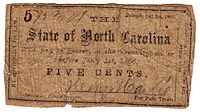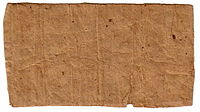- North Carolina 1861 5 cents banknote
-


Country Confederate States of America State North Carolina Year 1861 Denomination 5 cents The 5 cent bill from 1861 was among the smallest denomination bills printed during the confederacy of North Carolina. It was also one of the smallest physical bills, measuring approximately 3" by 1 5/8".[citation needed]. By 1863 barter was replacing currency and a tenpenny nail was used in place of this note.[1]
Contents
Text of the Bill
By Authority of Law. (left margin)
Raleigh, Oct. 1st, 1861.
The
State of North Carolina
Will pay to Bearer, at the Treasury, on or
before Jan'y 1st, 1866,
FIVE CENTS.J. Spelman, Public Printer.
(signed) For Pub. Treas.
Receivable in Payment of All Public Dues. (right margin)
Known Varieties
All of the 1861 North Carolina fractionals are known to exist with and without plate marks A and B (appearing above the word Carolina). Various paper and watermark combinations exist, as are bills printed on the backs of bonds and other denominations of notes.
Serial Numbers and Signatures
Known serial number / serial combinations include:
- 1042 A - S. H. Young
- 5289 - S. H. Young
- 79301 - Henry Hardie
References
- ^ Dodd, William Edward (1907). Jefferson Davis. University of Michigan: G.W. Jacobs & Company. p. 321. http://books.google.com/books?id=xtJ2AAAAMAAJ&pg=PA321&dq=%22North+Carolina%22+1861+5+cents+banknote&hl=en&ei=AcFaTdL5LYH58Abf2NTSDQ&sa=X&oi=book_result&ct=result&resnum=4&ved=0CFMQ6AEwAzgU#v=onepage&q=five%20cent&f=false.
Categories:- Historical currencies of the United States
Wikimedia Foundation. 2010.
